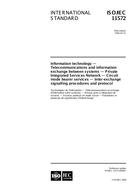-
-
Available Formats
- Options
- Availability
- Priced From ( in USD )
-
Available Formats
-
- Immediate download
-
$166.00Members pay $124.50
- Add to Cart
-
- Printed Edition
- Ships in 1-2 business days
-
$166.00Members pay $124.50
- Add to Cart
Customers Who Bought This Also Bought
-

ISO/IEC 11572:2000
Priced From $278.00 -

ISO/IEC 14136:1995
Priced From $194.00 -

ISO/IEC 21407:2001
Priced From $124.00 -

ISO/IEC 21989:2002
Priced From $223.00
About This Item
Full Description
This International Standard specifies the combination of base standards, together with the selection of appropriate options and parameter values, necessary to specify how QSIG / PSS1 can be used to provide digital signalling capabilities at interfaces at the C reference point between a Private Integrated services Network eXchange (PINX) and an Interconnecting Network (ICN) to permit interoperability between equipment from different vendors and different public or private service providers.
This International Standard is applicable to attached PINXs and Interconnecting Networks (ICN).
This International Standard identifies the necessary or optional employment of particular functions, procedures and services when provided:
- physical and electrical characteristics (physical layer) of the interfaces to the transmission systems to be employed;
- data link layer procedures;
- network layer procedures; and
- supplementary services and additional network features to meet specific corporate network user requirements.
This International Standard states requirements upon attached PINXs and Interconnecting Network (ICN) implementations in order to achieve interoperability between equipment in PISNs serving as Corporate telecommunication Networks (CNs).
ISO/IEC TR 14475 specifies various access arrangements between a PINX and a public network where reference points C and T reside either at a single or at separate interfaces. The scope of this International Standard is limited to cover the C reference point aspects at a separate interface.
The current version of this International Standard does not intend to specify any gateway or end PINX requirements for the ICN side of the interface. Therefore it typically uses the term “virtual transit PINX” instead of Interconnecting Network (ICN).





